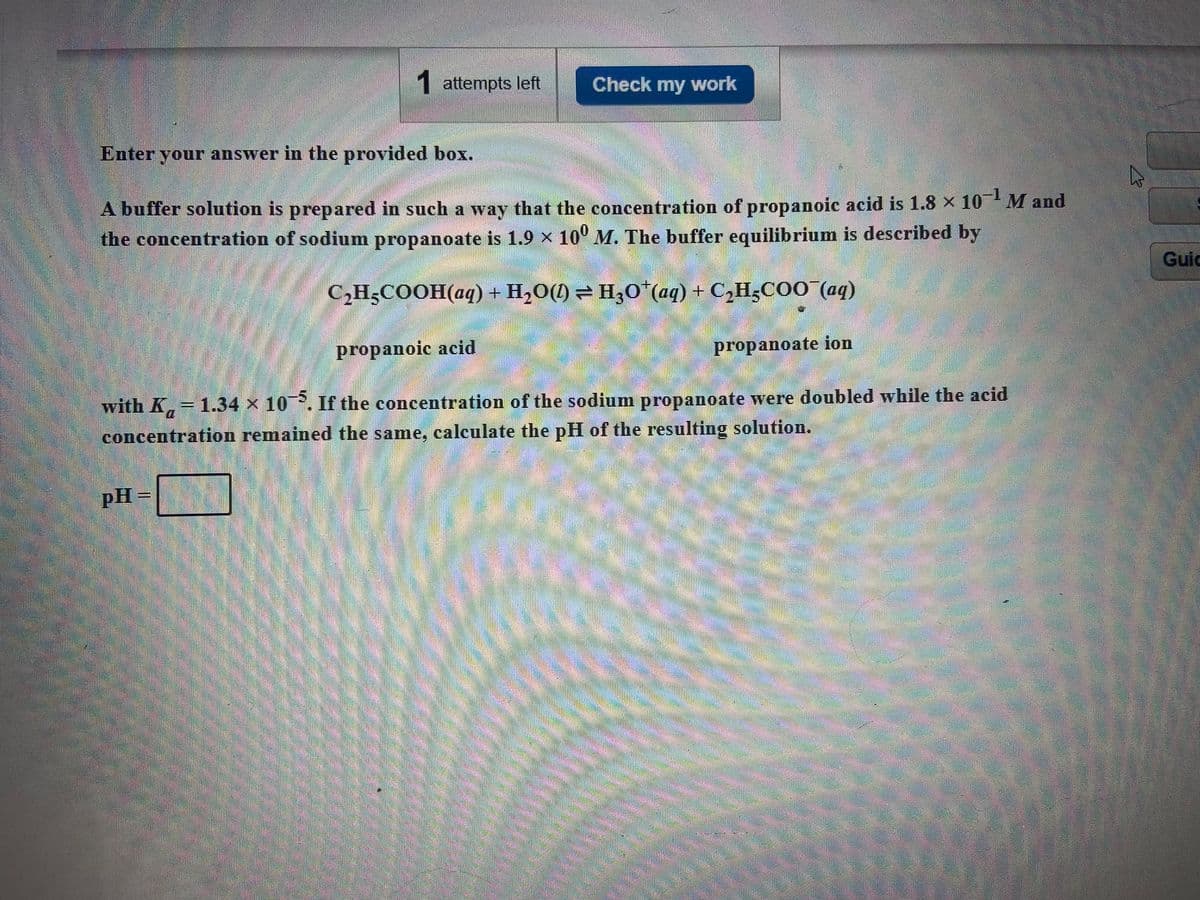A buffer solution is prepared in such a way that the concentration of propanoic acid is 1.8 x 10M and the concentration of sodium propanoate is 1.9 x 10° M. The buffer equilibrium is described by C2H;COOH(aq) + H,O(1) = H30*(aq) + C,H;COO¯(aq) propanoic acid propanoate ion with K,= 1.34 x 10. If the concentration of the sodium propanoate were doubled while the acid concentration remained the same, calculate the pH of the resulting solution. pH =
A buffer solution is prepared in such a way that the concentration of propanoic acid is 1.8 x 10M and the concentration of sodium propanoate is 1.9 x 10° M. The buffer equilibrium is described by C2H;COOH(aq) + H,O(1) = H30*(aq) + C,H;COO¯(aq) propanoic acid propanoate ion with K,= 1.34 x 10. If the concentration of the sodium propanoate were doubled while the acid concentration remained the same, calculate the pH of the resulting solution. pH =
Chemistry by OpenStax (2015-05-04)
1st Edition
ISBN:9781938168390
Author:Klaus Theopold, Richard H Langley, Paul Flowers, William R. Robinson, Mark Blaser
Publisher:Klaus Theopold, Richard H Langley, Paul Flowers, William R. Robinson, Mark Blaser
Chapter14: Acid-base Equilibria
Section: Chapter Questions
Problem 47E: Explain why equilibrium calculations are not necessary to determine ionic concentrations in...
Related questions
Question

Transcribed Image Text:1 attempts left
Check my work
Enter your answer in the provided box.
A buffer solution is prepared in such a way that the concentration of propanoic acid is 1.8 x 10 M and
the concentration of sodium propanoate is 1.9 x 10° M. The buffer equilibrium is described by
Guic
C,H;COOH(aq) + H2O(1) =H,o*(aq) + C,H3CO0aq)
propanoic acid
propanoate ion
with K 1.34 x 10P. If the concentration of the sodium propanoate were doubled while the acid
concentration remained the same, calculate the pH of the resulting solution.
pH =
Expert Solution
This question has been solved!
Explore an expertly crafted, step-by-step solution for a thorough understanding of key concepts.
This is a popular solution!
Trending now
This is a popular solution!
Step by step
Solved in 3 steps with 1 images

Knowledge Booster
Learn more about
Need a deep-dive on the concept behind this application? Look no further. Learn more about this topic, chemistry and related others by exploring similar questions and additional content below.Recommended textbooks for you

Chemistry by OpenStax (2015-05-04)
Chemistry
ISBN:
9781938168390
Author:
Klaus Theopold, Richard H Langley, Paul Flowers, William R. Robinson, Mark Blaser
Publisher:
OpenStax

Introduction to General, Organic and Biochemistry
Chemistry
ISBN:
9781285869759
Author:
Frederick A. Bettelheim, William H. Brown, Mary K. Campbell, Shawn O. Farrell, Omar Torres
Publisher:
Cengage Learning

Chemistry: Principles and Reactions
Chemistry
ISBN:
9781305079373
Author:
William L. Masterton, Cecile N. Hurley
Publisher:
Cengage Learning

Chemistry by OpenStax (2015-05-04)
Chemistry
ISBN:
9781938168390
Author:
Klaus Theopold, Richard H Langley, Paul Flowers, William R. Robinson, Mark Blaser
Publisher:
OpenStax

Introduction to General, Organic and Biochemistry
Chemistry
ISBN:
9781285869759
Author:
Frederick A. Bettelheim, William H. Brown, Mary K. Campbell, Shawn O. Farrell, Omar Torres
Publisher:
Cengage Learning

Chemistry: Principles and Reactions
Chemistry
ISBN:
9781305079373
Author:
William L. Masterton, Cecile N. Hurley
Publisher:
Cengage Learning

Chemistry: An Atoms First Approach
Chemistry
ISBN:
9781305079243
Author:
Steven S. Zumdahl, Susan A. Zumdahl
Publisher:
Cengage Learning

Chemistry
Chemistry
ISBN:
9781305957404
Author:
Steven S. Zumdahl, Susan A. Zumdahl, Donald J. DeCoste
Publisher:
Cengage Learning
